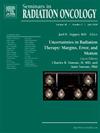PSMA-PET Guided Radiotherapy in Prostate Cancer: A Critical Review of Current Applications and Future Directions
IF 3.2
3区 医学
Q3 ONCOLOGY
引用次数: 0
Abstract
Prostate-specific membrane antigen/positron emission tomography (PSMA-PET) changed the diagnostic approach in prostate cancer (PCa), providing superior diagnostic accuracy compared to conventional imaging (CI) modalities like computed tomography (CT), bone scintigraphy (BS) or other PET radiopharmaceuticals like choline or fluciclovine. This improved diagnostic accuracy plays a crucial role in its synergy with radiotherapy, particularly in the context of metastasis-directed therapy. Even in advanced stages of prostate cancer, the synergy with radiotherapy is evident in the promising results emerging from the combination of RT and RLT. To evaluate the value of PSMA as biomarker, the technological advancements in PSMA-PET, and its integration into clinical practice, focusing on its impact on RT and RLT. A comprehensive nonsystematic literature review was performed using PubMed/MEDLINE and EMBASE biomedical databases. Literature search was updated until March 2025. The most relevant studies have been summarized, giving priority to registered clinical trials and multicenter collaborations. The higher accuracy of PSMA-PET is advancing RT planning in PCa, from initial staging to salvage and metastasis-directed therapy. Ongoing trials combining RLT with external beam radiotherapy (EBRT) may expand its role into earlier stages. Key challenges include the need for long-term outcome data, standardization, cost-effectiveness, and avoiding overtreatment. Future efforts should optimize PSMA-guided RT, evaluate novel RLT combinations, and identify predictive biomarkers for personalized care. The synergy between PSMA-PET and radiotherapy enables a more effective therapeutic approach across both early and advanced stages of PCa, particularly through the promising integration with RLT.
PSMA-PET引导前列腺癌放射治疗:当前应用和未来方向的综述
前列腺特异性膜抗原/正电子发射断层扫描(PSMA-PET)改变了前列腺癌(PCa)的诊断方法,与传统成像(CI)方式(如计算机断层扫描(CT)、骨显像(BS)或其他PET放射性药物(如胆碱或氟氯叶碱)相比,它提供了更高的诊断准确性。这种改进的诊断准确性在其与放疗的协同作用中起着至关重要的作用,特别是在转移导向治疗的背景下。即使在前列腺癌晚期,放射治疗与放疗的协同作用也很明显,这是由RT和RLT联合出现的有希望的结果。评估PSMA作为生物标志物的价值,PSMA- pet的技术进步及其与临床实践的结合,重点关注其对RT和RLT的影响。使用PubMed/MEDLINE和EMBASE生物医学数据库进行全面的非系统文献综述。文献检索更新至2025年3月。总结了最相关的研究,优先考虑注册临床试验和多中心合作。PSMA-PET的更高准确性正在推进前列腺癌的RT计划,从初始分期到挽救和转移导向治疗。正在进行的RLT与外部放射治疗(EBRT)联合的试验可能会将其作用扩展到早期阶段。主要挑战包括需要长期结果数据、标准化、成本效益和避免过度治疗。未来的工作应优化psma引导的RT,评估新的RLT组合,并确定个性化护理的预测性生物标志物。PSMA-PET和放疗之间的协同作用使早期和晚期PCa的治疗方法更加有效,特别是通过与RLT的有希望的整合。
本文章由计算机程序翻译,如有差异,请以英文原文为准。
求助全文
约1分钟内获得全文
求助全文
来源期刊
CiteScore
5.80
自引率
0.00%
发文量
48
审稿时长
>12 weeks
期刊介绍:
Each issue of Seminars in Radiation Oncology is compiled by a guest editor to address a specific topic in the specialty, presenting definitive information on areas of rapid change and development. A significant number of articles report new scientific information. Topics covered include tumor biology, diagnosis, medical and surgical management of the patient, and new technologies.

 求助内容:
求助内容: 应助结果提醒方式:
应助结果提醒方式:


